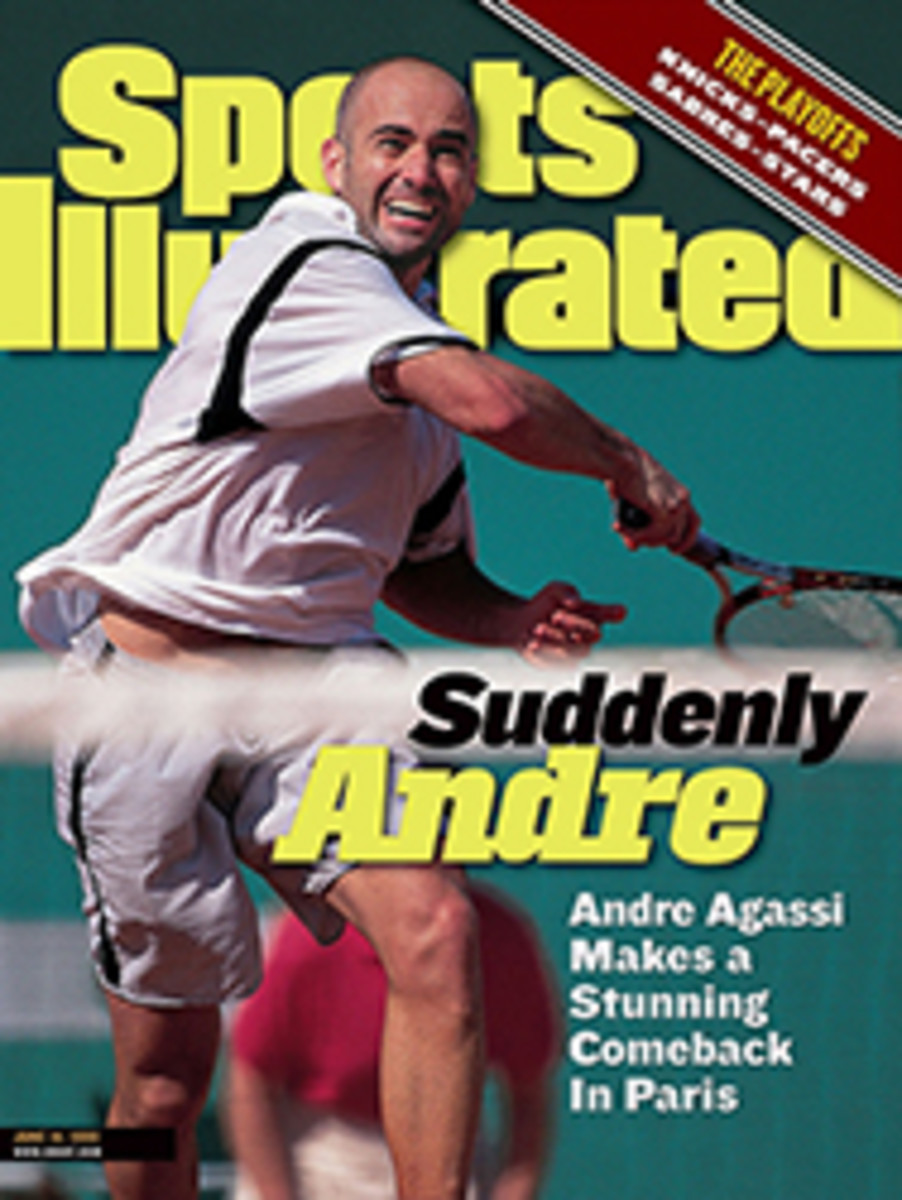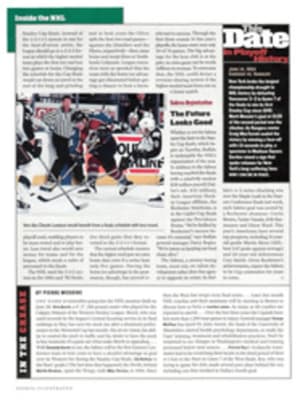
It's In The Stars Buffalo is good enough to thwart another finals sweep by the West, but Dallas nonetheless should roll to the Stanley Cup
Dallas Stars center Mike Modano was put to the ultimate
challenge, the single most formidable test facing modern NHL
players: You have 15 seconds to name as many Buffalo Sabres as
you can. A sly smile crossed Modano's lips, the corners of his
eyes crinkled with amusement. He plays hockey games, not parlor
games, and he wasn't about to be ambushed by a pop quiz last
Friday on which a score of anything less than 100 might be hung
on the other team's bulletin board. Time was ticking. Modano was
grinning. Finally he said, "I probably wouldn't get half."
He hadn't yet been reintroduced to the team that's going to save
the Stanley Cup finals. The NHL's showcase series--known as
Sweeps Week the past four years, not for its television ratings
but for the dominance the Western Conference has held over its
Eastern foes--has been an embarrassment as the trailing clubs
have drifted away like a schoolboy's attention in early June,
the Florida Panthers' worthy effort in 1996 excepted. The glut
of sweeps and the conspicuous strength of the top Western teams
have prompted respected hockey observers to suggest that
semifinal teams be reseeded to enhance the odds of a more
competitive Stanley Cup final, an idea that might snare more
television viewers but ignores the big picture of conference
rivalry. Enough. The NHL already has tinkered with its game to
distraction. There is nothing wrong with the playoff system that
this Buffalo team can't fix. The Sabres, anonymous even within
the mom-and-pop industry of hockey, won't beat the Stars for the
Cup, but they have the ability to salvage it from the tyranny of
another sweep.
At first glance Buffalo hardly seems the obvious candidate to
restore the luster to the loveliest trophy in sports. The Sabres
are ingenues in the championship business: None of them ever has
played on a Stanley Cup winner. Only five times in the last 71
years has a team won without having at least one player whose
name had previously been engraved on the trophy. (Dallas has
eight.) Arguably the most celebrated moment in Buffalo's
history, although probably not according to the ASPCA, occurred
when one of its players, Jim Lorentz, struck a bat with his
stick at the old Aud during a stoppage in play during Game 3 of
the 1974-75 finals.
Buffalo is also a modestly budgeted team that relies more on
homegrown talent than on free agency. But even if this Cup final
was supposed to be a foregone conclusion before it began, the
Sabres know they will be judged not by their pedigree but by
their game. They're quick, opportunistic, fun and hard to
discourage, one Cinderella who won't show up for the finals in a
gown. They spread the scoring around--first a Stu Barnes, then a
Geoff Sanderson will leap off the side of the milk carton and
into the game summary. Despite the 23-point differential between
the teams in the regular-season standings, this series figures
to be more nuanced than the simple Stars-versus-No Stars (other
than goalie Dominik Hasek) formulation would suggest.
This year's finals might not always be compelling given Dallas's
ability to convert the neutral zone into a minefield and
Buffalo's inclination to counterattack, but at least there
should be more than four games played. Stars director of player
personnel Craig Button says, "This is not even going to be close
to a sweep."
The 34-year-old Hasek would neither stand nor sprawl for it.
Conceivably this could be his last, best chance at a Stanley
Cup--expansion and the exigencies of a small market like Buffalo
point to that conclusion--and while he doesn't need a Cup to
validate his career, winning one might help in making the
argument that he's the best goalie ever. Hasek is the Sabres'
biggest weapon, the one player able to win games, if not a
series, by himself. Hasek has been nursing a pulled groin muscle
since February, and he missed the first two games of the Eastern
Conference finals against the Toronto Maple Leafs, but he looked
O.K. by his uniquely high standards while allowing six goals in
winning the last three games of the series.
Going into the finals Dallas knew it had to find a way to beat
Hasek. Actually the Stars, and the rest of the NHL, know the
best way to beat him: shoot high. For all his puck-stopping
genius, Hasek doesn't have an imposing glove hand. He doesn't
catch the puck above shoulder level as often as he swats at it
like a noisome mosquito at a backyard barbecue. The intriguing
question is not where to try to put the puck on Hasek, but how
best to get it there--a question that elicited an unconventional
response from Dallas scouts.
Tim Bernhardt, a former NHL goalie, developed this stratagem:
Instead of the traditional approach of buzzing Hasek and camping
outside his crease like paparazzi at Madonna's hotel--"I think
bumping him helps him get into the game," says Bernhardt, the
Stars' chief amateur scout--Dallas forwards were instructed to
pull back three to five feet. Hasek, who covers the bottom of
the net with the elasticity of a carnival freak, will probably
stop the initial shot in either case, but the buffer zone
between the forwards and the goalie will make for longer,
trickier deflections and give the Stars more room in which to
roof a rebound. "Good shooters put the puck where they want to,"
Button says. "Against Hasek, you have to find a way to give them
a better chance. The extra distance does that. Maybe you get him
thinking a little. If he has to stop and think about rebounds,
it's like a pitcher whose rhythm you've disrupted. Certainly
Hasek is the key. That team draws a ton of confidence from their
goalie and their captain."
Michael Peca, the Buffalo captain, is an old-time player at the
old-time size of 5'11" and 180 pounds. He's a fierce hitter,
precisely the reason the Stars will try to level Peca, a center,
before he has a chance to lay out the high-scoring Modano or
even Derian Hatcher, the punishing defenseman who is 6'5" and
230 pounds. Indeed, Peca could be vulnerable. There was
speculation last week that he is playing with bruised ribs. Peca
denied he was injured, but he failed to score a goal in the
semifinals against Toronto, and in recent weeks he has never
been bare-chested when the media invaded the Sabres' dressing
room.
Dallas also has targeted the Buffalo defense. The Stars want to
pummel defensemen Richard Smehlik, Rhett Warrener and Jay McKee
into coughing up the puck deep in their zone, but the Dallas
scouts decided that the offensive-minded Alexei Zhitnik, who
forms the No. 1 blueline pair with Smehlik, can be coaxed,
rather than battered, into committing turnovers. The Stars plan
to trap Zhitnik, lulling him into a false sense of security by
giving him room to carry the puck and then quickly cutting off
his ice and forcing a poor pass.
But Buffalo's power play, which failed to connect in only one
game in the first three rounds, gives Zhitnik the time and
expanse he craves. He and Jason Woolley, his partner on the
point on the Sabres' first man-advantage unit, are deft at
getting shots to the net through traffic, unlike Stars
power-play quarterback Sergei Zubov, who must lead the league in
shots on glass. Until now, however, Buffalo hasn't had to
contend with a team as good at shot blocking as Dallas. The
Stars throw their bodies in front of pucks when they must and
often even when they don't have to: In the last minute of the
4-1 victory in Game 7 over the Avalanche in the Western
Conference finals, Dallas players were still reflexively
dropping to stop shots before they could get to goalie Ed
Belfour. They're sticklers for keeping their sticks in the
passing and shooting lanes. Theirs isn't a defense as much as an
obstacle course. "This game isn't only about speed but about
mental speed," Button says. "Guys like Mike Keane, Mike Modano
and Guy Carbonneau--they're mentally quick. They know where to
be, and they know how to get there."
With Peca and wingers such as Sanderson and 40-goal-scorer
Miroslav Satan, the Sabres are as swift as the Avalanche, which
gaily ran relay races whenever Dallas deviated from its patient,
sometimes plodding, style. The Stars' defensemen, especially
38-year-old Craig Ludwig and 32-year-old Shawn Chambers, are so
vulnerable to outside speed that coach Ken Hitchcock had to
break up their partnership in the Colorado series and pair
Ludwig with the quick Zubov, and Chambers with the swift Darryl
Sydor. "If we can hit their D with speed," Buffalo pro scout
Terry Martin says, "that's to our advantage. But their whole
game is designed to rob you of that. See the job they did [in
the second period of Game 7 against Colorado]." The Stars played
a nearly perfect period, not allowing a shot for more than 14
minutes and ending up with almost as many Keane scores, two, as
the Avalanche did shots, three.
"Look at the way we play," Dallas center Joe Nieuwendyk says.
"We don't chase people. We let them come to us. We have some
pretty big defensemen that like to punish people. If we can
protect the slot and protect the neutral zone, all the speed in
the world isn't going to get through the wall of defensemen we
have."
The Sabres have a workingman's chance, one born of depth, an
aggressive penalty-killing style that Hitchcock concedes has
bothered his team, a pair of checking centers in Peca and Curtis
Brown who could frustrate Modano and Nieuwendyk and, of course,
Hasek. Buffalo will probe Belfour low and to the stick
side--four goals whizzed by that spot in Dallas's 7-5 loss to
Colorado in Game 5--and it will measure its ability to survive
in one-goal games against a team that as Bernhardt notes, rarely
blows anybody away.
"Fifteen seconds, huh?" Ludwig says in response to the question
that was first posed to Modano. "Hasek, Peca, Woolley, Satan,
[defenseman James] Patrick, Zhitnik, [tough guys] Paul Kruse and
Rob Ray. Time must be up. Did I do better than Modano?"
Ludwig did fine, and, ultimately, so will the Stars, a team with
the hubris to have adopted the slogan NOTHING ELSE MATTERS. But
before the Stars win the Cup in six games, the Sabres are going
to have more than their requisite 15 seconds of fame.
COLOR PHOTO: PHOTOGRAPH BY DAVID E. KLUTHO Wound up To score against Hasek, Modano (left) and the rest of the Stars will concentrate on shooting high to the glove side.
COLOR PHOTO: LOU CAPOZZOLA Crunch time Vaclav Varada (right) and the other Sabres can make names for themselves with hard hits like this one on Dimitri Yushkevich.
The Sabres are quick, fun and opportunistic, one Cinderella who
won't show up for the Cup finals in a gown.

